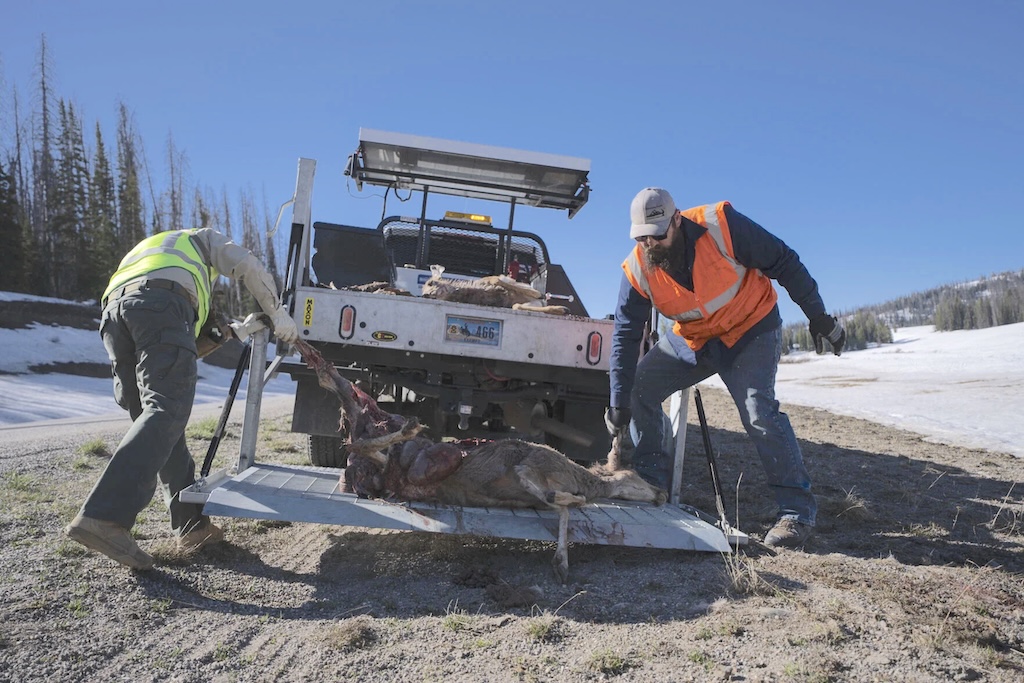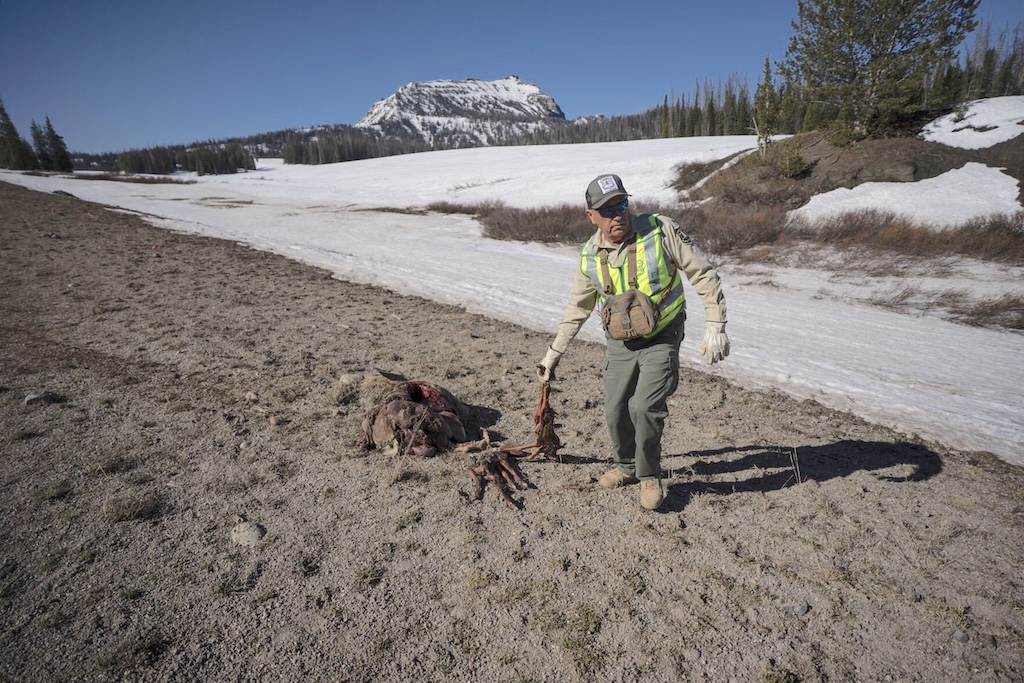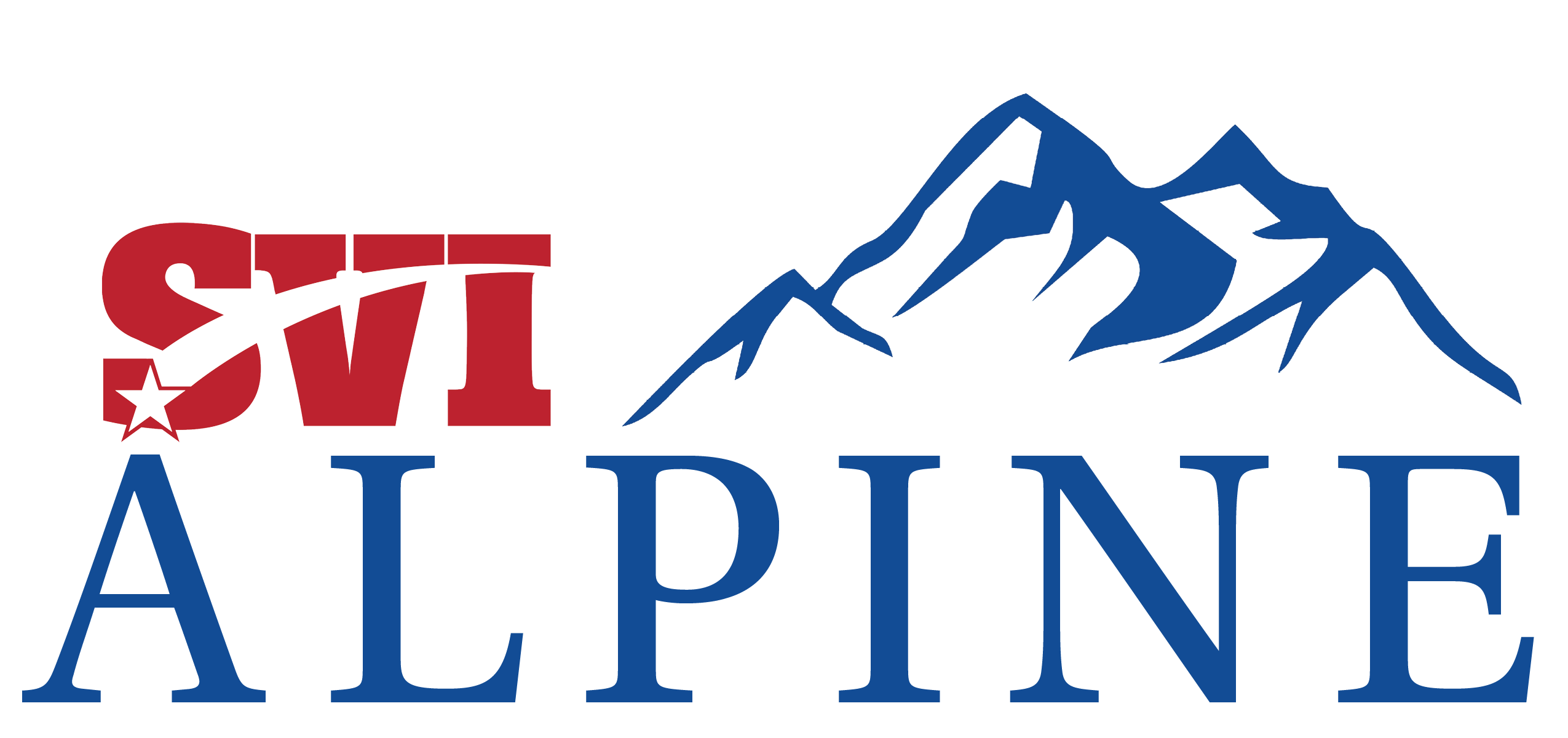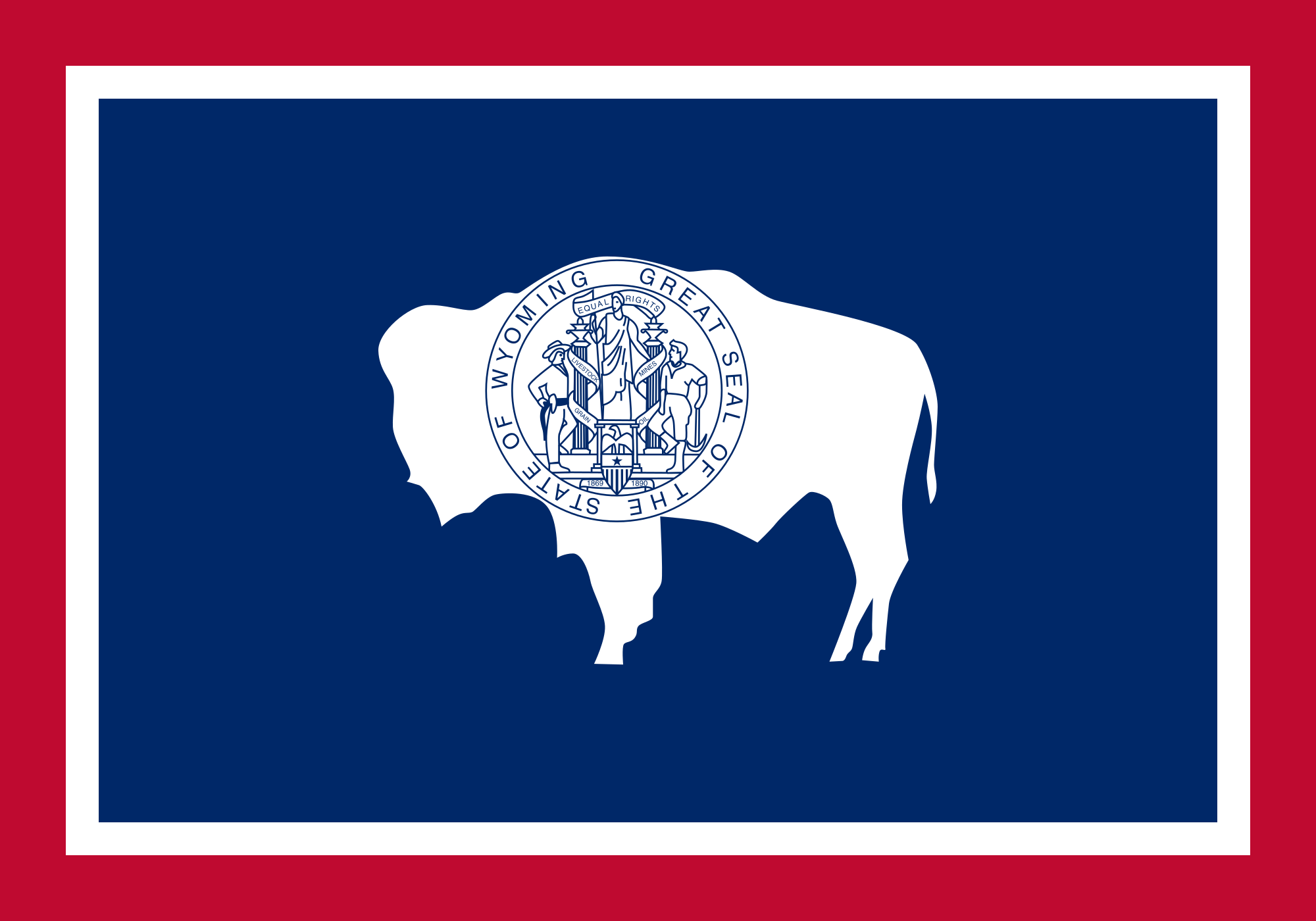Jackson Hole forest ambassadors worry lodging tax cuts could detract from dirty jobs
By Wyoming News Exchange
June 5, 2025

Gene Palos, a veteran ambassador for Friends of the Bridger-Teton, left, and Joshua Heron, an employee of the Wyoming Department of Transportation, right, load a dead doe onto the WYDOT truck lift Friday morning while clearing five deer carcasses from the roadside of Togwotee Pass. A vital role of wildlife management on Togwotee Pass involves clearing roadkill to avoid further human and wildlife conflicts. By Kathryn Ziesig, Jackson Hole News&Guide.
• Friends of the Bridger-Teton, other nonprofits, compete for ever smaller pool of cash.
By Charley Sutherland
Jackson Hole News&Guide
Via- Wyoming News Exchange
JACKSON — As Gene Palos drove over Togwotee Pass Friday morning, he spotted the carnage and pulled over.
Two mule deer does, likely struck by vehicles, were dead on the side of the road. Both were pregnant and appeared to have aborted their fawns, leaving them scattered along the highway. Palos, a volunteer wildlife ambassador with Friends of the Bridger-Teton, jumped into action. As Wyoming Department of Transportation worker Joshua Heron drove by, Palos flagged him down. Palos and Heron loaded the two deer and three fawns — one was pregnant with twins — onto a flatbed truck to haul them off.
Speed is integral to such an operation. As the day warms, dead deer get stinkier, stinky deer attract grizzly bears, grizzly bears attract wildlife watchers, and so on.
“People are going to stop,” Palos said. “They’re going to stop and take photographs because they don’t know any better, and now you’re next to a wild animal that’s going to protect what he’s eating.”
Friends of the Bridger-Teton, a now five-year-old nonprofit organization, funds Palos’ rented Toyota Tacoma, the shovel he used to scoop up the last of the deer guts, and the food Palos eats for dinner back at his trailer near the Blackrock Ranger Station, which he dubbed the “Taj Mahal.”
The nonprofit runs, in part, on lodging tax dollars granted to the organization through the Jackson Hole Travel and Tourism Board. But the board may soon reduce Friends of the Bridger-Teton’s funding, leaving the organization’s executive director Scott Kosiba worried a lack of funding could restrict the nonprofit at the same time that federal cuts hamstring the Forest Service. That could limit the number of people the Friends group can hire to do dirty work, like cleaning up deer carcasses on the side of Highway 26.
Last year, Friends of the Bridger-Teton received $646,626 from the Tourism Board. This year, the Tourism Board has set aside $550,000 for “ambassador services,” but six organizations are vying for the funds, seeking a total of $929,034.
Ambassadors ensure visitors have good experiences, but also promote safety by, for example, educating campers about fire danger and snuffing abandoned campfires, Kosiba said.
Out-of-state campers could leave “a giant fire going when they go into town,” Kosiba told the News&Guide Tuesday before a Tourism Board meeting where the funding was up for debate. “Then you run the risk of a human-caused wildfire.”
Budget constraints
Friends of the Bridger-Teton requested $600,000, Friends of Pathways requested $100,000, the Teton Backcountry Alliance requested $83,184, the Jackson Hole Nordic Alliance asked for $80,000, and the Bridger-Teton Avalanche Center requested $54,450. Teton Valley Trails and Pathways asked for $11,400. “Ambassadors” for those organizations patrol the Togwotee highway, Bridger-Teton campgrounds, bike paths on both sides of the Tetons, the Teton Pass parking area, cross country ski trails and backcountry ski terrain.
At a Tuesday meeting, board members didn’t decide which organizations to fund — or at what levels — after more than two hours of discussion. The board is set to resume the discussion on June 12.
At least five town and county elected officials watched as board members soberly grappled with their situation.
“We’re doing our best to give as much money as we can, but next year, we’re not even going to have $550,000 to give,” said Johanna Holbrook, a Travel and Tourism Board member. “The reality of that situation needs to be spoken.”
As Jackson Hole braced for the COVID-19 pandemic, the Tourism Board expected less visitation and planned to spend less, Tourism Board Executive Director Crista Valentino previously told the News&Guide. But that didn’t happen. Tourism exploded instead, and the Tourism Board, funded by lodging tax, accumulated reserves. Before 2020, voters also had to approve the lodging tax every two years and the board pinched pennies in case its funding source dried up. In the past five years, it has spent down those savings, Valentino said.
Now, the board has less to spend, and organizations that relied on those dollars are wondering if their funding will dry up.
In the past few years, Friends of the Bridger-Teton has sought more funding from outside sources, including the U.S. Department of Agriculture, grants, permitting fees and private donations.
In 2022, the Tourism Board awarded the nonprofit $586,277, 66% of the organizations’ overall budget. In 2023, the board granted Friends of the Bridger-Teton $789,334, amounting to 56% of its budget. Last year, the board awarded $646,626, 46% of the Friends’ budget. If the Tourism Board awarded Friends of the Bridger-Teton its full $650,000 ask, that money would make up 32% of the organizations’ budget for this year.
Still, the organization’s request is by far the largest in front of the Tourism Board, which spent considerable time reviewing it on Tuesday.
‘Doomsday scenario’
Shelby Scharp, a Tourism Board member, did not appreciate what she perceived as Kosiba’s framing that wildfires could break out and burn uncontrolled without Tourism Board support. Scharp recently sued Teton County, alleging the affordable and worker housing fees the county charged her and her husband to build their Hoback home were unconstitutional. She participated in Tuesday’s meeting over the Zoom call.
“It’s a little misleading,” Scharp said, “to give a real doomsday scenario” to their budget request.
Other Tourism Board members were quick to disagree.
Board member Mike May said he’s spoken with ambassadors who have physically put out escaped camp fires.
“That’s the sort of thing that keeps me up at night,” he said.
Friends of the Bridger-Teton has extinguished 800 escaped wildfires since its inception, Kosiba told the board during the meeting.
But Scharp argued that Friends of the Bridger-Teton’s current funding model could have unintended consequences. If the Tourism Board continues to fund Friends of the Bridger-Teton, bolstering work the federal government should be doing, the federal government may just choose to reduce Forest Service funding, Scharp said. If a nonprofit, partially funded by lodging tax, is funding that work, why would the federal government pay for it?
Kosiba countered, saying he’d be happy to “walk out the door” if the Forest Service was adequately funded, but that’s not the situation.
“It’s frankly insane that a nonprofit like mine needs to exist to support a federal agency” at all, Kosiba said.
Federal cuts represent an “existential threat” to Friends of the Bridger-Teton, Kosiba said.
“It is not our job to replace the work that the Forest Service does,” he added. “However, it is also our mission to make sure that our public lands are maintained.”

Gene Palos gathers two dead fetal deer next to their deceased mother who had been hit by a vehicle atop Towgotee Pass on Friday morning. An unfortunate but vital part of Palos’s job as ambassador for Friends of the Bridger-Teton is managing road kill and keeping humans from conflicting with the bears. By Kathryn Ziesig, Jackson Hole News&Guide.
Bad timing
As President Donald Trump and the Department of Government Efficiency has sought to dramatically reduce the size of the federal workforce, the Bridger-Teton National Forest has lost many seasonal employees. Friends of the Bridger-Teton just hired a five-member forest corps with private philanthropic funds to try to fill in gaps. Kosiba described that as “trying to plug a lot of holes in a very leaky boat.”
A few days earlier on Togwotee Pass, Palos, the forest ambassador, was cleaning up another problem: The dead deer.
If a hungry grizzly bear saw the deer as a tasty road-side snack, it could be difficult for wildlife officials to move the bear away from the road, Palos said. They could consider killing the bear, or hazing it away from the road, and the bear could pose a safety threat to amused visitors. Palos told the journalists accompanying him to keep their heads on a swivel in case a grizzly sniffed the kill and pursued it while he and Heron, the Wyoming Department of Transportation worker, moved it off the road.
“It’s a real problem,” Palos said from his truck after the clean-up. “We have to try to get to them as soon as we can.”
He’s hopeful his co-workers can fill in some of the workforce gaps federal funding cuts have created. In his view, the ambassador program helps to “offset” those reductions.
“I’m just here to help,” he said.

